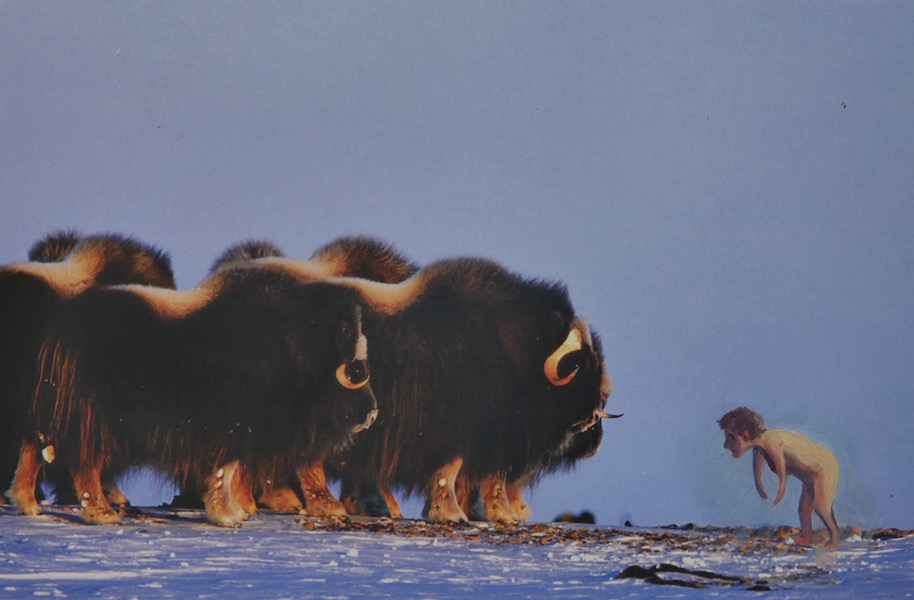In: Disabled Artists

Bison Greeting (detail from Wildlife) | Sunaura Taylor, 2014
February 10, 2023Bison Greeting (detail from Wildlife) | Sunaura Taylor, 2014
“And you took the patronizing tone of an animal-trainer. Have you any idea what it is like to be spoken to in the way people speak to animals? A fascinating experience. Gives you quite a new feeling about animals. They don’t know words, but they understand tones. The tone people usually use to animals is affectionate, but it has an undertone of ‘What a fool you are!’ I suppose an animal has to make up its mind whether it will put up with that nonsense for the food and shelter that goes with it, or show the speaker who’s boss. That’s what I did.”
(Robertson Davies, World of Wonders)
I was introduced to Sunaura Taylor’s artwork by a friend who is a minister, and whose ministry is often focused upon the vulnerable in our Niagara community. We often share artists that interest us back and forth, as my own knowledge of contemporary religious painters appeals to her more progressive sensibilities. This image has a specific resonance to me. After spending so much time on the Canadian prairie the history of the use and abuse of the buffalo – and ideas now that tie buffalos metaphorically to different ways of thinking about society and our actions within it (through an Indigenous lens) with an aim to being ‘better’ and more inclusive as citizens within nations states – are factors in looking at Taylor’s painting.
Taylor’s visual art is striking, offering narratives that are both personal and offer a wider commentary on contemporary society. She is the recipient of a 2008 Joan Mitchell Foundation Award.
Her words: “My paintings are not at all only about the body, but the body is inevitably an aspect of my relationship with whatever it is that I am seeing.”
More: “I also want to paint and see politics, because I was born into them. I have a rare congenital disability called Arthrogryposis that was caused by toxic waste contamination in our groundwater, from the world’s largest polluter, the US military. I use a wheelchair for mobility and my mouth to paint. I grew up in a household of artists and anti-war activists, which perhaps made the knowledge that my body was formed by the industry of war, even more traumatic. I began at twelve to express myself and deal with these emotions through paint.”
Both quotes are from here, and I encourage you to visit that site to consider more of her erudite commentary, and see more of her paintings there.
“Sunaura Taylor is an artist, writer, academic, and an activist for both disability rights and animal rights. Her artwork has been displayed internationally and she is currently an assistant professor at UC Berkeley where she teaches classes in animal studies and environmental justice.
Taylor utilizes her lived experience as a disabled person to present new ways of thinking about disability and animals. Through each strand of her multifaceted work, she examines and challenges what it is to be human, what it is to be animal, and how the exploitation and oppression of both are entwined.” (from here)
While considering Taylor’s work, I was also reading Becoming Kin: An Indigenous Call to Unforgetting the Past and Reimagining Our Future by Patty Krawec (interestingly, this book was suggested to me by the same friend who introduced me to Taylor’s artwork): there is a story she relates that I’d like to end with, as a final response to Bison Greeting.
“In the spring, the people laid their tobacco on the ground as an offering, and they prayed and sang. Then they sent out runners in the four directions looking for the deer. These runners ran and ran, covering great distances, and one by one they returned. Nothing. Nothing. Nothing. Finally—maybe because this is how it is in stories—the last runner came back and said she had found one young deer, far to the north. This young one had told her that the deer had felt disrespected and threatened. So they left.
The young deer explained that initially they had waited to see if the humans would remember what we knew. But seeing from our behavior that we had no interest in relationship, and no interest in maintaining the agreements we had made with them, they left. This must have been a difficult decision because of the promise that they had made to the Creator that they would take care of us. The deer needed to think about their own survival, though. If we killed them all, they wouldn’t be here to take care of us anyway.
The people sent their diplomats, their elders, and their ceremonial people to meet with the deer, and for as much time as it took, they listened. They listened to the stories and to the harm they had done. They listened to old relationships and memory. They listened to how things should be. They made offerings and agreements.
Only then did the deer return to them. The people agreed to live in respect for the deer. They agreed to take care of the relationship that takes care of them.”
More of Sunaura Taylor’s artwork and writing can be found here and here.
~ Bart Gazzola
Read More
Recent Comments